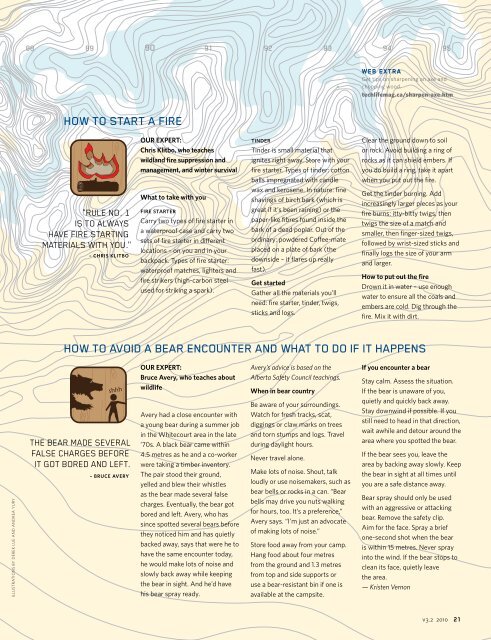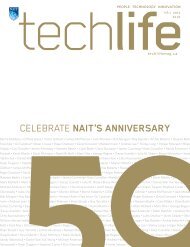Read the full print edition - techlife magazine
Read the full print edition - techlife magazine
Read the full print edition - techlife magazine
Create successful ePaper yourself
Turn your PDF publications into a flip-book with our unique Google optimized e-Paper software.
illustrations by derek lue and andrea yury<br />
88 89 90 91 92 93 94 95<br />
hOw tO StARt A fIRe<br />
“rule no. 1<br />
is to alWays<br />
have Fire starting<br />
materials With you.”<br />
– chris klitbO<br />
Our expert:<br />
chris klitbo, who teaches<br />
wildland fire suppression and<br />
management, and winter survival<br />
What to take with you<br />
fire starter<br />
Carry two types of fire starter in<br />
a waterproof case and carry two<br />
sets of fire starter in different<br />
locations – on you and in your<br />
backpack. Types of fire starter:<br />
waterproof matches, lighters and<br />
fire strikers (high-carbon steel<br />
used for striking a spark).<br />
Our expert:<br />
bruce avery, who teaches about<br />
wildlife<br />
Avery had a close encounter with<br />
a young bear during a summer job<br />
in <strong>the</strong> Whitecourt area in <strong>the</strong> late<br />
’70s. A black bear came within<br />
4.5 metres as he and a co-worker<br />
were taking a timber inventory.<br />
The pair stood <strong>the</strong>ir ground,<br />
yelled and blew <strong>the</strong>ir whistles<br />
as <strong>the</strong> bear made several false<br />
charges. Eventually, <strong>the</strong> bear got<br />
bored and left. Avery, who has<br />
since spotted several bears before<br />
<strong>the</strong>y noticed him and has quietly<br />
backed away, says that were he to<br />
have <strong>the</strong> same encounter today,<br />
he would make lots of noise and<br />
slowly back away while keeping<br />
<strong>the</strong> bear in sight. And he’d have<br />
his bear spray ready.<br />
tinder<br />
Tinder is small material that<br />
ignites right away. Store with your<br />
fire starter. Types of tinder: cotton<br />
balls impregnated with candle<br />
wax and kerosene. In nature: fine<br />
shavings of birch bark (which is<br />
great if it’s been raining) or <strong>the</strong><br />
paper-like fibres found inside <strong>the</strong><br />
bark of a dead poplar. Out of <strong>the</strong><br />
ordinary: powdered Coffee-mate<br />
placed on a plate of bark (<strong>the</strong><br />
downside – it flares up really<br />
fast).<br />
get started<br />
Ga<strong>the</strong>r all <strong>the</strong> materials you’ll<br />
need: fire starter, tinder, twigs,<br />
sticks and logs.<br />
Avery’s advice is based on <strong>the</strong><br />
Alberta Safety Council teachings.<br />
When in bear country<br />
Be aware of your surroundings.<br />
Watch for fresh tracks, scat,<br />
diggings or claw marks on trees<br />
and torn stumps and logs. Travel<br />
during daylight hours.<br />
Never travel alone.<br />
Make lots of noise. Shout, talk<br />
loudly or use noisemakers, such as<br />
bear bells or rocks in a can. “Bear<br />
bells may drive you nuts walking<br />
for hours, too. It’s a preference,”<br />
Avery says. “I’m just an advocate<br />
of making lots of noise.”<br />
Store food away from your camp.<br />
Hang food about four metres<br />
from <strong>the</strong> ground and 1.3 metres<br />
from top and side supports or<br />
use a bear-resistant bin if one is<br />
available at <strong>the</strong> campsite.<br />
Clear <strong>the</strong> ground down to soil<br />
or rock. Avoid building a ring of<br />
rocks as it can shield embers. If<br />
you do build a ring, take it apart<br />
when you put out <strong>the</strong> fire.<br />
Get <strong>the</strong> tinder burning. Add<br />
increasingly larger pieces as your<br />
fire burns: itty-bitty twigs, <strong>the</strong>n<br />
twigs <strong>the</strong> size of a match and<br />
smaller, <strong>the</strong>n finger-sized twigs,<br />
followed by wrist-sized sticks and<br />
finally logs <strong>the</strong> size of your arm<br />
and larger.<br />
how to put out <strong>the</strong> fire<br />
Drown it in water – use enough<br />
water to ensure all <strong>the</strong> coals and<br />
embers are cold. Dig through <strong>the</strong><br />
fire. Mix it with dirt.<br />
hOw tO AvOID A beAR encOunteR AnD whAt tO DO If It hAPPenS<br />
<strong>the</strong> bear maDe several<br />
False charges beFore<br />
it got boreD anD leFt.<br />
– bruce aVery<br />
Web Extra<br />
Get tips on sharpening an axe and<br />
chopping wood.<br />
<strong>techlife</strong>mag.ca/sharpen-axe.htm<br />
if you encounter a bear<br />
Stay calm. Assess <strong>the</strong> situation.<br />
If <strong>the</strong> bear is unaware of you,<br />
quietly and quickly back away.<br />
Stay downwind if possible. If you<br />
still need to head in that direction,<br />
wait awhile and detour around <strong>the</strong><br />
area where you spotted <strong>the</strong> bear.<br />
If <strong>the</strong> bear sees you, leave <strong>the</strong><br />
area by backing away slowly. Keep<br />
<strong>the</strong> bear in sight at all times until<br />
you are a safe distance away.<br />
Bear spray should only be used<br />
with an aggressive or attacking<br />
bear. Remove <strong>the</strong> safety clip.<br />
Aim for <strong>the</strong> face. Spray a brief<br />
one-second shot when <strong>the</strong> bear<br />
is within 15 metres. Never spray<br />
into <strong>the</strong> wind. If <strong>the</strong> bear stops to<br />
clean its face, quietly leave<br />
<strong>the</strong> area.<br />
— Kristen Vernon<br />
v3.2 2010 21










